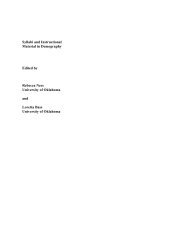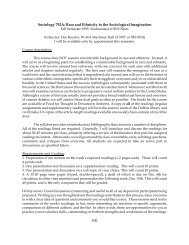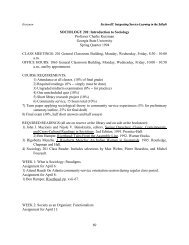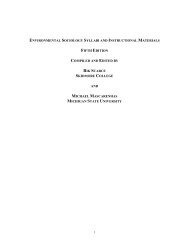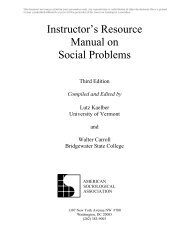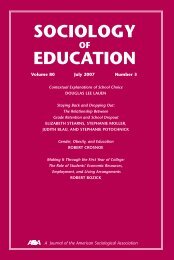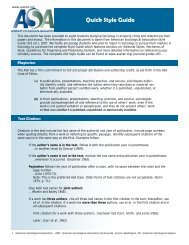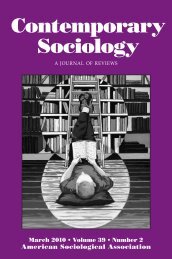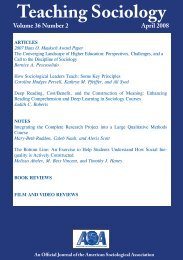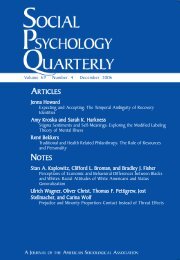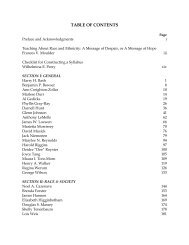Teaching Sociology - American Sociological Association
Teaching Sociology - American Sociological Association
Teaching Sociology - American Sociological Association
Create successful ePaper yourself
Turn your PDF publications into a flip-book with our unique Google optimized e-Paper software.
STATEMENT OF ASA POLICY ON MULTIPLE SUBMISSION<br />
“Submission of manuscripts to a professional journal clearly implies commitment to publish in that journal. The<br />
competition for journal space requires a great deal of time and effort on the part of editorial readers whose main<br />
compensation for this service is the opportunity to read papers prior to publication and the gratification associated<br />
with discharge of professional obligations. For these reasons, the ASA regards submission of a manuscript to a<br />
professional journal while that paper is under review by another journal as unacceptable.”<br />
Section II.B4, ASA Code of Ethics<br />
MANUSCRIPT PROCESSING FEE<br />
A processing fee of $25.00 is required for each paper submitted, except reviews. (Fees are waived for student<br />
members of the ASA and associate editors of <strong>Teaching</strong> <strong>Sociology</strong>.) This practice reflects a policy of the ASA<br />
Council and Committee on Publications. A check or money order payable to the <strong>American</strong> <strong>Sociological</strong><br />
<strong>Association</strong> should accompany each submission. The fee must be paid in order to initiate manuscript processing.<br />
Manuscripts that are revisions of papers previously declined by <strong>Teaching</strong> <strong>Sociology</strong>, but not revisions of<br />
manuscripts for which the previous outcome was a request to revise and resubmit, will be assessed an additional<br />
$25.00.<br />
MANUSCRIPT SUBMISSION AND PROCESSING<br />
• Formats: <strong>Teaching</strong> <strong>Sociology</strong> publishes several types of papers. Generally an article is about 25 pages long, is<br />
analytical and/or empirical, and is based on appropriate literature. A note is usually less than 15 pages long,<br />
contains a brief literature review, and describes a specific idea, strategy, or technique. Applications are typically<br />
20 pages in length and are solicited by the editor. <strong>Teaching</strong> <strong>Sociology</strong> does not accept unsolicited applications<br />
manuscripts. Conversations should be no longer than eight pages (about 2,000 words) and are meant to<br />
encourage lively, thoughtful, and controversial discussion. For more information on these formats, see the<br />
“Guidelines for Papers Submitted to <strong>Teaching</strong> <strong>Sociology</strong>.”<br />
• Email one (1) electronic copy of the manuscript to TS@mail.ucf.edu. Include an email address for<br />
acknowledgment of manuscript receipt and regular mailing address for correspondence.<br />
• Manuscripts are reviewed anonymously. Authors’ names, affiliations, and other identifying material such as<br />
acknowledgments or personal references should be placed on the title page only, or on other separate pages<br />
preceding the text. It is the authors’ responsibility to remove all identifying information before submitting a<br />
manuscript.<br />
• All papers should include an abstract of no more than 150 words on a separate page.<br />
• Manuscripts must be typed, double-spaced (including footnotes, biography, acknowledgments, abstracts,<br />
references, indented material, and tables), and paginated. Place footnotes at the end of the manuscript. Margins<br />
should be at least one-inch wide all around.<br />
• Type each table and figure on a separate page. Figures must be prepared professionally. Place<br />
acknowledgments, credits, grant numbers, corresponding address, and e-mail on the title page and mark with an<br />
asterisk. If you include this information, place an asterisk after the title.<br />
• Manuscripts accepted for publication are subject to copyediting.<br />
• Clarify all symbols with notes in the margins of the manuscript. Circle these and all other explanatory notes not<br />
intended for printing.<br />
• Three kinds of footnotes are possible, each serving a different purpose:<br />
A. Content footnotes: Content footnotes are explanations or amplifications of the text. Because they are<br />
distracting to readers, an author should include important information in the text and omit irrelevant<br />
information. Content footnotes generally will not be allowed.<br />
Rather than footnoting long or complicated material, such as proofs or derivations unnecessary to the text,<br />
consider 1) stating in a short footnote that the material is available from the author, 2) depositing the material<br />
in a national retrieval center and including an appropriate footnote, or 3) adding an appendix. If you use an<br />
appendix, the reference in the text should read “(see Appendix for complete derivation)”.<br />
Number the text footnotes consecutively throughout the article with superscript Arabic numerals. If you<br />
mention a footnote later in the text, return to it with a parenthetical note (“see Footnote 3”) rather than<br />
repeating the superscript number.<br />
B. Reference footnotes: Use footnotes for reference only to cite material of limited availability. Acceptable<br />
reference footnotes include 1) legal citations, which should follow the footnote style of “A Uniform System<br />
of Citation” (Harvard Law Review <strong>Association</strong> 1967), 2) copyright permission footnotes, 3) unpublished<br />
works, and 4) works in progress.<br />
C. Table footnotes: Table footnotes are appended only to a specific table. Footnotes to a table should be lettered<br />
consecutively within each table with superscript lowercase letters.<br />
Revised: November 5, 2007<br />
NOTICE TO CONTRIBUTORS



